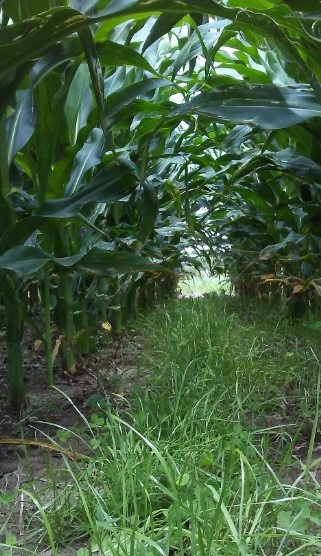By Hannah Rusch, Jeff Coulter, Julie Grossman, Gregg Johnson, Paul Porter, and Axel Garcia y Garcia
Cover crops can be used to extend the period of vegetative cover on soils. They take up water and nutrients and can reduce risk of nutrient losses from cropping systems. Additionally, cover crops help to hold soils in place and protect them from erosion. This reduces loss of nutrients bound to surface soil particles such as phosphorus.

Fitting cover crops into corn cropping systems in the upper Midwest poses a challenge for cover crop establishment, given the limited number of growing degree days after harvesting corn and soybean and before the onset of frost. One strategy to overcome this limitation is to interseed cover crops into corn and soybean before harvest. Previous work in Minnesota assessed drill-interseeding cover crops into corn at the seven leaf collar stage (Noland et al., 2018) and aerially interseeding cereal rye into corn shortly before harvest (Wilson et al., 2013). These timings were selected to avoid cover crop competition with corn and enhance the success cover crop establishment.
Field experiments
In 2017 and 2018, we broadcast-interseeded cover crops at the five leaf collar stage of corn in mid- to late June in field experiments conducted at University of Minnesota Research and Outreach Centers in Grand Rapids, Lamberton, and Waseca. The objectives were to evaluate the ability of interseeded cover crop monocultures and mixtures to establish and grow under a corn canopy and their effect on corn yield.
Treatments were (Fig. 1):
- Two grass monocultures [annual ryegrass (AR) and cereal rye (CR)].
- Two mixtures of a grass + crimson clover (ARCC and CRCC).
- Two mixtures of a grass + crimson clover + forage radish (ARCCFR and CRCCFR).
- Two no cover crop controls were also included.
Cover crops were established before the corn canopy closed and persisted throughout the growing season. Corn grain was harvested and the cover crops continued to grow until the onset of frost. Cover crop canopy cover and biomass were measured at fall frost and in the spring before cover crops were terminated with herbicide.
Cover crop establishment and growth
Cover crop canopy cover and biomass at fall frost varied by location, year, and cover crop treatment (Fig. 2). Within a location, differences in canopy cover and biomass occurred among cover crop treatments in 2017. In 2018, however, differences occurred only at Grand Rapids. Across locations in both years, treatments with AR had greater canopy cover in the fall than treatments with CR.
Figure 2. Cover crop canopy cover (a) and biomass (b) at fall frost and prior to termination in spring for treatments with monoculture or mixtures of annual ryegrass (AR), crimson clover (CC), forage radish (FR), and cereal rye (CR) at Grand Rapids (GR), Lamberton (LA), and Waseca (WA), MN.
Spring regrowth of CR was minimal at all locations in 2018 and 2019, and no CR regrew at Lamberton in 2019 (Fig. 2). When cover crops did regrow, canopy cover and biomass did not exceed 2.5% and 310 lb dry matter/acre, respectively, and there were no differences among cover crop treatments. The limited spring regrowth of CR in this study contradicts the findings of most other studies from the upper Midwest, which consistently show that CR successfully overwinters and regrows in the spring when drilled in the fall after corn or soybean harvest. Compared to these studies, reduced spring regrowth of CR in this study could be related to less seed-to-soil contact due to method of seeding (broadcasting versus drilling) and shading from corn.
Variation in cover crop establishment and regrowth in this study may be explained, in part, by weather conditions. In 2018, Lamberton and Waseca experienced abundant rainfall in the summer and fall, which led to ponding and subsequent loss of cover crops at both locations (Table 1). Additionally, spring air temperatures in 2018 and 2019 were cool and late snowfall occurred in both years.
Corn yield
Corn grain yield was not affected by cover crops interseeded at the five leaf collar stage at any location in both years. Across treatments and years, corn yield averaged 151 bushels/acre at Grand Rapids, 197 bushels/acre at Lamberton, and 180 bushels/acre at Waseca. This suggests that environmental benefits of cover crops such as reduced nutrient losses and soil erosion may be obtained without a penalty to corn yield. This study also highlights the potential of AR to be an equivalent or superior option to CR when interseeded alone or in a mixture with other cover crops at the five leaf collar stage of corn. Research to further develop and optimize strategies for cover crop establishment to achieve agronomic and environmental benefits is ongoing.